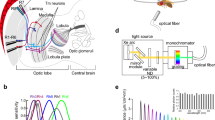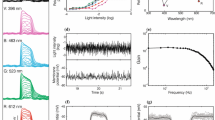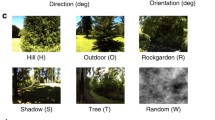Summary
-
1.
Light adapted retinular cell responses of the desert locust (Schistocerca gregaria) are shown to have finer time resolution and higher frequency response than those of the house cricket (Acheta domesticus), and these responses conform to earlier observations relating flicker-fusion frequencies of the electroretinogram to flight behavior in certain insects.
-
2.
The amplitude and phase frequency response characteristics and their dependence on mean intensity for the locust and the cricket are similar toLimulus, but distinctly different fromCalliphora (Zettler, 1969) at similar light intensities. The relationship of the Fuortes-Hodgkin model to these observations is discussed.
-
3.
The signal to noise ratios of the sinusoidal responses are never higher than 4 to 1.
-
4.
Pulse responses of both the locust and the cricket are predicted from the inverse Fourier transform of the frequency response.
-
5.
The three measured parameters in the response to steps of light, i.e., latency, initial slope and final level in the steady state, and incremental gain as a function of mean light intensity are similar for the locust and the cricket andLimulus, and the Fuortes-Hodgkin model.
Similar content being viewed by others
References
Alawi, A., Pak, W.: On-transient of insect electroretinogram: Its cellular origin. Science172, 1055–1057 (1971).
Autrum, H.: Die Belichtungspotentiale und das Sehen der Insekten (Untersuchungen anGalliphora undDixippus). Z. vergl. Physiol.32, 176–227 (1950).
Dodge, F. A., Knight, B. W., Toyoda, J.: Voltage noiss inLimulus visual cells. Science160, 88–90 (1968).
Fielden, A.: Transmission through the last abdominal ganglion of the dragonfly nymph,Anax imperator. J. exp. Biol.37, 832–844 (1960).
Fuortes, M. G. F., Hodgkin, A. L.: Changes in time scale and sensitivity in the Ommatidia ofLimulus. J. Physiol. (Lond.)172, 239–263 (1964).
Hoyle, G.: Potassium ions and insect nerve muscle. J. exp. Biol.30, 121–135 (1953).
Knight, B. W., Dodge, F. A., Toyoda, J.: A quantitative description of the dynamics of excitation and inhibition in the eye ofLimulus. J. gen. Physiol.56, 421–437 (1970).
Pinter, R. B.: A study of the dynamic properties of the generator potential of theLimulus photoreceptor. Ph. D. Dissertation. Northwestern University, Evanston, Illinois (1964).
Pinter, R. B.: Sinusoidal and delta function responses of visual cells of theLimulus eye. J. gen. Physiol.49, 565–593 (1966).
Shaw, S. R.: Organization of the locust retina. Symp. Zool. Soc. Lond.23, 135–163 (1968).
Shaw, S. R.: Optics of the arthropod compound eye. Science164, 88–90 (1969).
Vishnevskaya, T. M., Mazokhin-Porshnyakov, G. A.: Electrical and spectral properties of the visual cells of the grasshopper (Tettigonia) and the cricket (Gryllus). Biofizika14, 158–165 (1969).
Zettler, F.: Die Abhängigkeit des Übertragungsverhaltens von Frequenz und Adaptationszustand; gemessen am einzelnen Lichtrezeptor vonCalliphora erythrocephala. Z. vergl. Physiol.64, 432–449 (1969).
Author information
Authors and Affiliations
Additional information
This research has been supported by NIH grant GM-16436-04 to Dr. R. F. Rushmer, Chairman of the Bioengineering Division of the University of Washington. Computer time has been supported by NIH grant BR 00374 to Dr. T. H. Kehl of the Department of Physiology and Biophysics, University of Washington. Appreciation is extended to Dr. John M. Palka for sharing of his facilities, and advice, and to Dr. John S. Edwards for advice and crickets. Thanks are extended to Dr. John Phillips of the University of British Columbia for the supply of locusts, and to Dr. Dennis Willows for assistance.
Rights and permissions
About this article
Cite this article
Pinter, R.B. Frequency and time domain properties of retinular cells of the desert locust (Schistocerca gregaria) and the house cricket (Acheta domesticus). J. Comp. Physiol. 77, 383–397 (1972). https://doi.org/10.1007/BF00694942
Received:
Issue Date:
DOI: https://doi.org/10.1007/BF00694942




